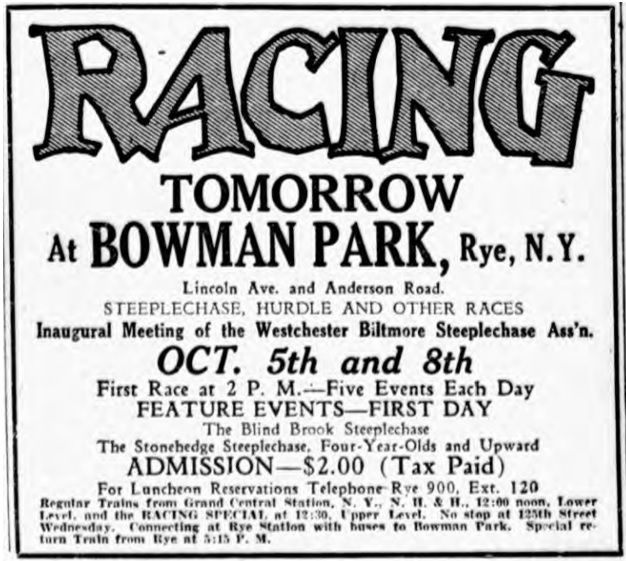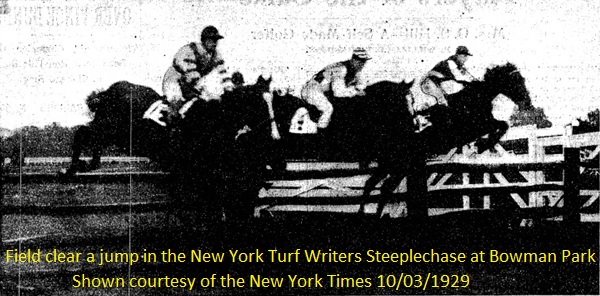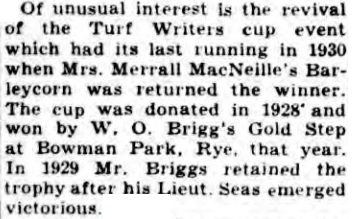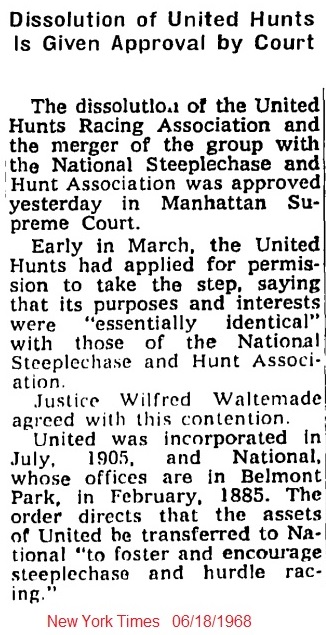I am grateful to Bill Orzell for the excellent article shown below, part of his 'Jumping from Long Island to Westchester' and 'The New UBS Arena Has A Fine Pedigree' articles. He has also written articles on a number of former racecourses and important buildings associated with racecourses, including Belmont Park Terminal Racecourse & Manice Mansion/Turf & Field Club
As the season of Belmont Park Terminal Racecourse neared its end, a new venue was Bowman Park, later to become Blind Brook. The old proverb; “if you are going to drink the water, you should know who dug the well” still seems to ring true. It is possible through research to understand events, and their time-lines, but it is very difficult to uncover motivations. I believe though in this case, the closing of one track directly led to the creation of another to replace it. Mr. Bowman was building a luxury resort north of Manhattan in Rye, New York. Construction of this exclusive retreat had begun a few years before the end of the Terminal track. This facility encompassed several hundred acres, and the construction taking place was setting a new standard for accommodation and resident services. Mr. Bowman decided this location, in Westchester County between the waters of the Hudson River and Long Island Sound, would provide a solution for United Hunts losing their competition site in Metropolitan New York. This well-planned facility had numerous provisions for horse sports, such as polo, hunting, and miles of bridle paths supported by well-equipped stables. He had the decided advantage of enlisting the support of Harry Buck, veteran racing secretary and industry insider who played a key role in salvaging New York racing, to assist him in making his new enterprise a success. The New York Sun of October 4, 1927 mentioned,
“Finishing touches are being given Bowman Park, the steeplechase course of the Westchester Biltmore Steeplechase Association, and visitors who journey tomorrow to the new home for sport will find every convenience and comfort and one of the most complete racing plants that have been provided anywhere. Turf writers and others who have visited the park are impressed by the natural adaptability of the tract of more than 125 acres for the purpose. John McEntee Bowman, president of the association, dominant factor in all that has been done to make that section of Westchester County attractive for sportsmen, has spent money liberally in the development of his latest enterprise. . . The grass that covers the course is in perfect condition and provides an Ideal cushion for every kind of race that has been carded during the two days of the inaugural meeting. The fences and hurdles on the main racing oval are portable and they will be removed for the flat races.The main racing strip is an oval of one mile and three furlongs, with stretches sixty feet wide. The cross-country course of about three and a half miles takes in the oval and reaches out to the rougher acres back of the main oval, curving in to provide constant view of the contests. This cross-country course is saddle shaped, with a sweep that is not unlike that which made Morris Park so attractive. There are three roomy stands that will provide seats for 7,000 spectators, and the comfortable club house, with its balconies, will be well patronized. Each of the stands has been covered. Parking space for more than 3,000 automobiles has been graded and cleared to the rear of the stands and along the upper furlongs of the stretch. The trip to Bowman Park if made in an automobile carries the visitor through miles of the most attractive section of Westchester County, providing glimpses of the wandering Bronx River and country estates. There are permanent stables adjacent to the paddock for more than one hundred horses and a couple of hundred other horses may be comfortable in temporary quarters located within a few hundred yards of the paddock. Owners need have no hesitancy about shipping their horses, for Mr. Bowman has made every provision for their comfort. Large tents and marquees have been erected for kitchens and dining rooms and complete equipment for an army of cooks has been installed. Tables have been engaged in advance for a large number of luncheon parties.”
The track side dining did leave a lasting impression, and noted turf columnist W.C. ‘Bill’ Vreeland remarked on the pages of the Brooklyn Daily Eagle that,
“The big feature which is part and parcel of the afternoon of racing at Bowman Park—and yet is something apart—is the buffet luncheon in a tent alongside the course.”

The second season at Bowman Park was more exciting than the first, with Amelia Earhart shooting touch-and-go’s on the polo grounds in her Avro Avian, while she resided at the Putnam residence in Rye, completing her first book (20 Hrs., 40 Min. Our Flight in the Friendship).
The Westchester venue was popular from the outset, and the picturesque scenic beauty and high level of service developed a fine reputation for Bowman Park. The October 5, 1929 Rye Chronicle reported,
“All the boxes at Bowman Park have been reserved and a record crowd is looked for . . . the Seventh Regiment Band will play and an extra touch of color will be provided by the presence of twenty members of the first class of cadets from West Point.”
Mr. Bowman sold his holdings in Westchester County to a party of investors which included himself. I believe this would be termed “taking on partners,” and this group included future NYRA Chairman (and Westchester resident) John W. Hanes. The property was divided, and many of the finest homes in America were built there. Other desirable features were the renowned Westchester and Blind Brook Country Clubs. Alas, some prolonged poor autumn weather and Mr. Bowman’s health became negative issues for the track, and their fifth season was unfortunately cancelled. In late October 1931, John McEntee Bowman died following complications from gallbladder surgery. It seems a great injustice indeed that he was only given 56 years to apply himself, and he had no ease in retirement.
After Mr. Bowman’s death, the United Hunts Racing Association relocated back to the Metropolitan New York area, and with some of their events held on private Long Island estates. These unfortunate circumstances of upheaval put the New York Turf Writers’ Cup event into an extended hiatus, not returning until 1938 at Belmont Park.

“There is in Westchester one of the most completely equipped horse centers in the East, the Blind Brook Turf and Polo Club, formerly known as Bowman Park, which stands as a memorial of one of New York's most enthusiastic horsemen, the late John McEntee Bowman. First laid out in 1926, this development, with facilities for polo, horse shows, race meetings and steeplechases, has now a splendid carpeting of hoof-proof turf, and also a layout of grandstands, boxes, parking spaces and club house which eclipses anything available for hunt race fans at even the more historic meetings.”
The turf oval was thought to present conditions found in Europe, and the facility even adopted the Continental, or clockwise racing direction. Some of the biggest names in jump competition, jockeys, trainers and owners took part in events in Westchester County. For example the aforementioned consulting jump jockey Bill Street delighted the crowd on an October day in 1930 by landing his airplane on the infield just in time to don silks and ride Mrs. Thomas W. Durant’s Falmouth in the Westchester-Biltmore Gold Cup steeplechase; he finished second. In September of 1934, Benjamin Leslie Behr’s eleven year old gelding Brose Hover won the featured Connecticut Cup. Mrs. Thomas W. Durant’s Gil Blas won the Ox Ridge Plate under W. Burley Cocks, his second win on the day, having scored on Sir Gareth in the first race, which was on the flat. Another flat race, the Goldens Bridge Plate was won by Carroll Bassett on the aptly named Hustle. The following September at Blind Brook, the bay gelding Lucier, a son of McGee, won the Connecticut Cup and in the Adjacent Hunts Trophy Race, Stewart Janney, Jr. came to grief. The tall, towheaded Noel Laing, training for Mrs. T.H. Somerville (Marion DuPont Scott) and riding her entry Welbourne Jake, snarled with Mr. Janney’s Justian II and went down at a fence, with Mr. Laing unfortunately breaking his collarbone. Mrs. Pete Bostwick’s timber topper Fugitive won the Connecticut Cup for the second time in 1937. Texan Clyde Nix won three races in 1948, two of them belonging to F. Ambrose Clark. The 1950 Connecticut Cup was won by Elizabeth Bosley’s eight year old gelding, Mister Mars. George H. ‘Pete’ Bostwick, who rode multiple times in the Grand National at Aintree and had won at the Belmont Park Terminal Course, was trainer at Blind Brook for his sister, Mrs. Ogden Phipps. Mrs. Pete Bostwick and Mrs. Paul Mellon both had entries, as did Paul Mellon and his cousin Richard K. Mellon. Pat and Mike Smithwick, very successful jump jockey and trainer respectively, were regular participants at Blind Brook. Paddy had a particularly successful day in October of 1958 when he won four of his mounts including the Port Chester Turf Plate, and in 1962 he was back to win the annually featured Connecticut Cup on Mrs. June H. McKnight’s chestnut gelding, Hill Tie. Blind Brook was Mrs. McKnight’s home track, literally, as Miss June Hanes she grew up just down the street. In 1958 Burley Cocks saddled the Connecticut Cup winner, Carolina Hills, a son of Hilltown whose 18 year old rider/owner Bill Turner took him three miles over 17 treacherous timber fences. Crafty trainer Mickey Walsh made numerous appearances in the Blind Brook winner’s circle, most often with his nephew and rider, Tommy Walsh. County Kildare native Jimmy Mahoney rode several entries at Blind Brook for Cooperstown’s stalwart Mrs. F. Ambrose Clark. In 1966 Doug Small, Jr. rode the bay gelding Prudent Lover to victory in the featured Connecticut Cup to the delight of his connections, owners Mr. and Mrs. Valentine of Virginia, and trainer Burley Cocks, who was also his father-in-law. Syndicated and celebrated sports writer Red Smith, detailed these events at Blind Brook in his June 6 column where he described rail birds rooting on Jockey Small, who had married Burley’s daughter Susan, with his track nickname, Batman. Red Smith goes on to mention how Burley Cocks played a role in the careers of steeplechasers Paddy and Mike Smithwick and Mike Freeman. Legendary Red in his own inimitable way continues,
“Burley married Babs Lucas in 1940 and a year later started training for Mrs. Fay Ingalls, owner of the Homestead in Hot Springs, VA. She bought two weanlings at the dispersal of Willis Sharpe Kilmer's racing stock and named them Beaubabs and Surgi Burley for the Cockses. Today, 25 years later, Burley still is winning races for Mrs. Ingalls with descendants of this pair.”
Pari-mutuel wagering was introduced at the Purchase, New York track in 1948, with the approval of the New York State Racing Commission, replacing the betting rings that formerly existed. Adjacent Hunts annually would donate proceeds from their events at Blind Brook to various charities such as the Boys Club of New York, the Damon Runyon Memorial Fund for Cancer Research, the Fresh Air Fund, and the United States Equestrian Team. As with major stakes competitions elsewhere, Adjacent Hunts held a ball for the social side of its membership. The 1952 occasion was notable for its guest of honor, ingénue film star Audrey Hepburn.
Perennial favorite performers at Blind Brook were of course their own polo team, but also the Cadets of the nearby United States Military Academy’s polo squad from West Point. Some of the other great polo teams, and the best players in the world bowled there as well, including the United Kingdom’s National team, and that of their then colony in India. Other international performers that created much interest and brought out the crowds were performances by the United States Olympic Equestrian Team. Their performance at Blind Brook in early June of 1936 might be the best remembered, as following their presentation there, they entrained for the Port of New York where they sailed for Berlin to compete in the Olympic Games that featured Jesse Owens, Adolf Hitler and the airship Hindenburg.
Some of the flaws at Blind Brook provided much of the special allure that pervaded the environs with the unusual, yet delightful, combination of quirky and quaint. Such as the pari-mutual building that resembled a worn out chicken coop with canvas tacked to the windward side, and an unreliable public address system, which converted the race call into a delivery which might be considered politically incorrect in our time. Without an electronic tote board, the probable odds were chalked on to slates that were hauled aloft for display on a rope and pulley arrangement, which was something between a spinnaker and a clothes line, and less-than smooth working. At a May 1963 event, the supply of programs was exhausted prior to all the patrons arriving, which led to many impromptu introductions between the haves and have-nots. Most of the ‘stoopers’ at Blind Brook were under five years of age, and built close to the ground. The turf writers up from the Big Apple to cover the events, often could not resist good natured ribbing of their county cousins. The time that the mutual clerks paid off before the race was declared official was never forgotten. Michael Strauss wrote in the May 27, 1962 New York Times,
“in contrast to the de luxe [sic] betting accommodations at such wagering palaces as Belmont Park and Aqueduct, today’s patrons toned themselves down to a rustic set-up. . . the major up-to-date touch was provided by a large squad of Pinkertons. As the crowd was an orderly one, the private police did little more than mop their brow.”



“at today’s 18th annual Adjacent Hunts meet, such deficiencies only added to the charm. They call it the Adjacent Hunts meet because a group of hunt clubs from this area combine forces to sponsor it. Actually, it isn’t very adjacent to anything else on the American pari-mutuel parade. This one-day card, staged in the woodsy setting of the Blind Brook Polo and Turf Club, is racing of the far-out variety.

As usual, everybody mingled with everybody else in this tweedy blending of family picnic, race track and back-of-the-stadium football party. Touts mingled with gulls, jockeys mingled with bettors, bettors mingled with bookies. . . The sign designating the jockey room was typical of the casual atmosphere. It consisted of a piece of white cardboard with the word “Jockeys” scrawled on it in red crayon.”
Steve Cady’s article, quoted above, garnered him the National Steeplechase and Hunt Associations, “Best News Story of the Year” Award.
Chris Wood, who was field director of the United Hunts Racing Association, acted as the public address race caller during the 1960’s at Blind Brook, but the winds of change were blowing across Westchester County. The disposition of the property of the Blind Brook Turf and Polo Club began to greatly change in the latter part of the decade with Pepsi’s interest in relocating from New York City. Needless to say, the nearby residents were less than pleased with these proposals, and of losing the bucolic vista of their verdant long time and good neighbor. The residents joined together, and made attempts to prevent the proposed development, such as voting to incorporate as a village, and thereby assume zoning control. This effort became one more example that “you can’t fight city hall.” The die had been cast, and the sylvan setting that had provided so much pleasure would be lost to posterity, and the bugle’s call heard no more.
The final events at Blind Brook Turf & Polo Club took place in 1967, and included the fiftieth anniversary of the Westchester Kennel Club show, and polo matches. The New York Times of October 31, 1967 reported that the Blind Brook mallet men defeated Connecticut 11-6 in the final polo match at Blind Brook Turf & Polo Club. George H. (Pete) Bostwick was the referee, and Herb Pennell was umpire. Having these two legends of steeplechasing and polo participate seemed like a fitting and sentimental ending to competition at the Blind Brook Turf & Polo Club. This location is presently the global headquarters of Pepsico (which can be viewed in Google Maps at 700 Anderson Hill Rd, Purchase, NY 10577).



